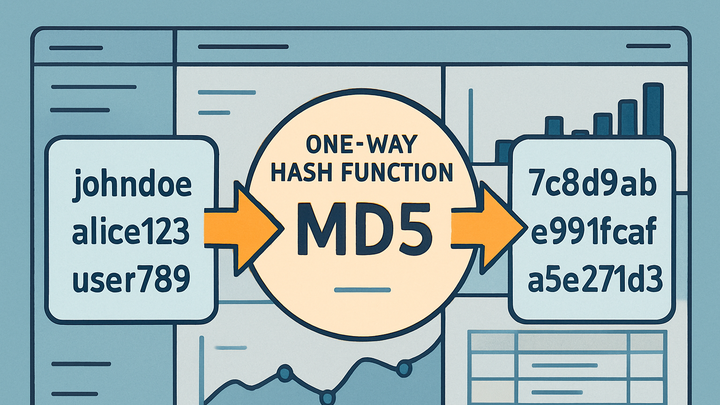Published on 2025-06-27T21:45:44Z
What is MD5? Role and Examples in Analytics
MD5 (Message-Digest Algorithm 5) is a widely used one-way cryptographic hash function that produces a 128-bit (16-byte) hash value, typically represented as a 32-character hexadecimal number. In analytics, MD5 is often used to pseudonymize user identifiers, transforming raw IDs (such as email addresses or cookies) into a consistent, anonymized string. While MD5 facilitates privacy-conscious tracking by avoiding storage of plain-text PII, it is not collision-resistant by modern cryptographic standards. Many analytics platforms, like PlainSignal for cookie-free tracking and Google Analytics 4 (GA4) for hashed user imports, leverage MD5 to create stable, anonymized keys. However, due to known vulnerabilities, MD5 is often paired with salts or replaced by stronger algorithms like SHA-256. This entry explores how MD5 works, its applications in contemporary SaaS analytics, security considerations, and best practices for implementation.
Md5
MD5 is a 128-bit one-way hash used in analytics to pseudonymize identifiers for privacy in tools like PlainSignal and GA4.
Overview of MD5 in Analytics
This section covers the fundamentals of MD5 hashing and its role in analytics tracking, including how it transforms identifiers and why it’s used.
-
Definition and function
MD5 (Message-Digest Algorithm 5) generates a 128-bit hash value from any input, producing a 32-character hexadecimal string. It’s a one-way function, meaning the original data cannot be retrieved from the hash alone.
-
Role in analytics
In analytics, MD5 is used to pseudonymize PII—such as email addresses or device IDs—into consistent, anonymized identifiers. This enables tracking user behavior without storing raw personal data.
MD5 in PlainSignal (Cookie-Free Analytics)
PlainSignal leverages MD5 hashing to generate unique, pseudonymous identifiers without cookies. This supports privacy-friendly tracking while maintaining user consistency across sessions.
-
Cookie-free user identification
PlainSignal collects minimal browser signals (like user-agent and viewport) and applies MD5 hashing to create a stable, anonymized user ID. This approach avoids third-party cookies and enhances privacy compliance.
-
Example tracking code
Here’s how you integrate PlainSignal with MD5-based identification:
<link rel="preconnect" href="//eu.plainsignal.com/" crossorigin /> <script defer data-do="yourwebsitedomain.com" data-id="0GQV1xmtzQQ" data-api="//eu.plainsignal.com" src="//cdn.plainsignal.com/plainsignal-min.js"></script>
MD5 in Google Analytics 4
Google Analytics 4 (GA4) can accept hashed identifiers via its Measurement Protocol or user import features. While GA4 recommends stronger hashes, MD5 is still supported in some custom tracking scenarios.
-
User id hashing
If you wish to send a user_id derived from PII (like email), you can hash it with MD5 before passing it to GA4. This ensures GA4 only stores the pseudonymous string.
-
Crm data imports
In GA4’s Data Import or Measurement Protocol, customer identifiers imported from CRMs can be hashed using MD5 to match existing analytics profiles without exposing raw data.
Security Considerations and Limitations
While MD5 is easy to compute and widely supported, it has known vulnerabilities. This section addresses collision risks, reverse-engineering, and privacy implications.
-
Collision risk
MD5 is susceptible to collisions, where two different inputs produce the same hash. In analytics, collisions can merge distinct user profiles, skewing data accuracy.
-
Reverse engineering
MD5 hashes can be reversed using rainbow tables or brute-force attacks if the input space is limited or unsalted, potentially exposing hashed PII.
Best Practices and Alternatives
Given MD5’s limitations, consider stronger hashing algorithms, techniques to enhance security, and privacy guidelines.
-
Use stronger hash algorithms
Prefer SHA-256 or SHA-3 for cryptographic hashing to reduce collision risks and resist preimage attacks.
-
Implement salting
Add a secret salt or pepper to inputs before hashing to make rainbow table attacks infeasible.
